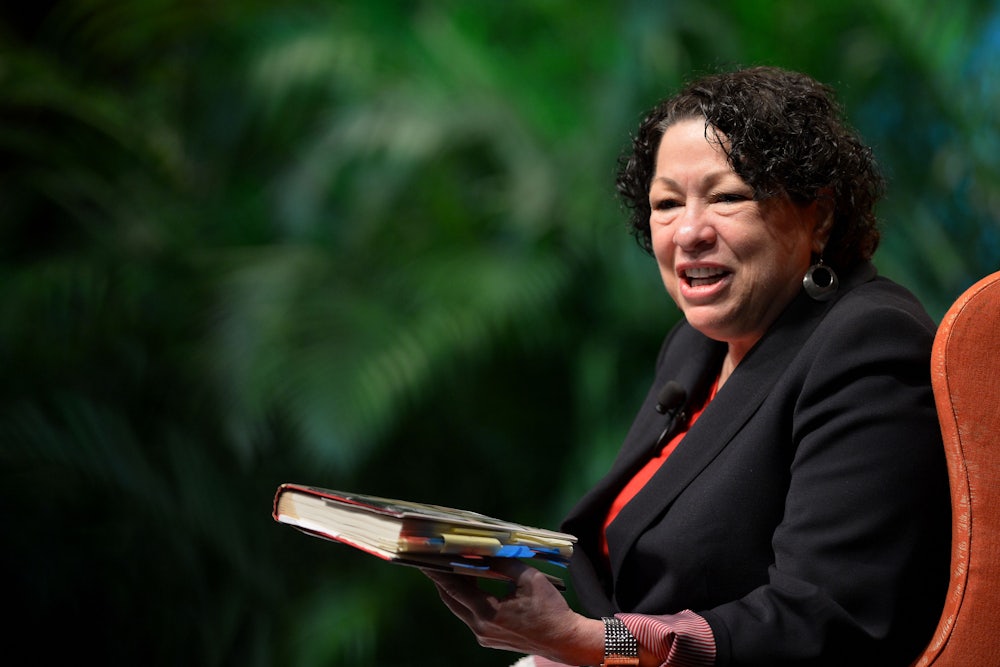The Supreme Court receives thousands of petitions for review each year. It agrees to hear only a handful of them. The rest are denied without any explanation whatsoever. Occasionally, however, one of the justices sheds some light on the court’s potential thinking about a particular case by writing a separate statement with the denial.
Justice Sonia Sotomayor did just that on Monday in Mckesson v. Doe, a potentially significant First Amendment case. The Fifth Circuit Court of Appeals held last year that the organizers of public protests are liable for civil damages for any illegal act committed by a protester, even if the organizer did not encourage or support it. The Supreme Court declined to review that ruling.
I noted in February that allowing the Fifth Circuit’s ruling to stand would seriously imperil the right to protest, at least within that court’s jurisdiction. It opens up protest organizers to serious financial damages through no fault of their own for engaging in constitutionally protected activities. But the court’s decision on Monday to not hear the case does not necessarily suggest that a status quo, to the detriment of some citizens’ First Amendment rights, will endure.
Instead, Sotomayor wrote, the Fifth Circuit may now have to reconsider its previous ruling based on Counterman v. Colorado, a First Amendment case that was decided by the high court last term. “Because this court may deny certiorari for many reasons, including that the law is not in need of further clarification, its denial today expresses no view about the merits of Mckesson’s claim,” she wrote in a statement on the court’s decision. “Although the Fifth Circuit did not have the benefit of this Court’s recent decision in Counterman when it issued its opinion, the lower courts now do.”
The case itself comes from a lawsuit by an anonymous Louisiana police officer against Deray Mckesson, a prominent leader in the Black Lives Matter movement. In the summer of 2016, two Baton Rouge police officers shot and killed Alton Sterling, an unarmed Black man, outside a convenience store. Video of the killing went viral online amid a national reckoning with police violence against Black Americans.
Mckesson, who became a prominent figure in the BLM movement that year, organized a protest in Baton Rouge shortly after the killing. What began as a peaceful demonstration soon turned confrontational. According to the anonymous police officer, someone in the crowd threw a rock at him that caused serious injuries.
The officer filed a lawsuit against Mckesson and others for their alleged role in his injury. While Mckesson played no personal role in the rock-throwing, the officer argued that Mckesson was liable for his injuries because he had organized the protest and knew it could potentially turn violent. He claimed that Louisiana law allowed him to sue Mckesson for, among other things, negligence.
A federal district court dismissed those claims, citing the 1982 case NAACP v. Claiborne Hardware Store. In Claiborne, the Supreme Court held that the First Amendment barred civil lawsuits against nonviolent protest organizers. That restriction applied even if some protesters turned violent against individuals or destructive toward property.
The Fifth Circuit, however, overturned the lower court’s ruling and reinstated the negligence claim. In 2020, the Supreme Court summarily reversed the Fifth Circuit—meaning that it overturned the decision without holding arguments or further briefing—because the appeals court hadn’t asked the Louisiana Supreme Court to weigh in on how to interpret the state negligence law in question.
Once the Louisiana Supreme Court did so, a three-judge panel on the Fifth Circuit affirmed its previous ruling. In the 2–1 ruling, the majority tried to distinguish the police officer’s lawsuit from Claiborne on murky grounds, including by claiming that since violence had occurred during the protest, Mckesson should have known that it would be dangerous before he organized it.
One of the panel’s members, Judge Don Willett, dissented from the panel’s ruling by arguing that his colleagues were drawing unnecessary distinctions with Claiborne that ultimately avoided its entire framework. Claiborne, he wrote, made protest leaders liable for damages based on whether they had acted violently or nonviolently themselves. By invoking negligence, Willett noted, the plaintiff was merely transmuting nonviolent acts into violent ones.
Willett also pointed to the practical consequences of the court’s decision. Adopting the officer’s theory of negligence during the civil rights movement would have led to “ruinous financial liability” for its leaders. “Had Dr. [Martin Luther] King been sued, either by injured police or injured protestors, I cannot fathom that the Constitution he praised as ‘magnificent’—‘a promissory note to which every American was to fall heir’—would countenance his personal liability,” he wrote.
A few days after the Fifth Circuit’s decision last summer, the Supreme Court decided Counterman v. Colorado. That case involved a Colorado man named Billy Counterman who sent bizarre and threatening Facebook messages to a local singer, despite her repeated attempts to block him. The state eventually charged him under a statute that made it a crime to “repeatedly” send communications to someone that would cause that person “serious emotional distress.”
Counterman sought to overturn his conviction on First Amendment grounds, arguing that his remarks did not rise to the level of a “true threat.” While the First Amendment protects a wide range of speech, the courts have long held that “true threats of violence” do not fall under its scope. In their ruling, the justices affirmed that prosecutors must show that the defendant subjectively understood his statements to be threatening.
At the same time, the justices also held that a “mental state of recklessness” would be enough to meet that threshold. “[Colorado] must show that the defendant consciously disregarded a substantial risk that his communications would be viewed as threatening violence,” Justice Elena Kagan wrote for the 7–2 majority. “The State need not prove any more demanding form of subjective intent to threaten another.” Since Colorado prosecuted him under a different standard, the court ruled that it had violated the First Amendment.
Sending threatening Facebook messages does not appear to have much in common with organizing protests against police violence, at first glance. But both cases involve questions of how far the First Amendment goes to protect speech that is, shall we say, adjacent to the possibility of violence. In Counterman, the justices referred to Claiborne multiple times. Kagan, writing for the majority, cited Claiborne alongside other cases to note that the First Amendment “precludes punishment, whether civil or criminal, unless the speaker’s words were ‘intended’ (not just likely) to produce imminent disorder.”
She also noted that, in incitement cases, the court has often recognized that “incitement to disorder is commonly a hair’s-breadth away from political ‘advocacy’—and particularly from strong protests against the government and prevailing social order,” again pointing to Claiborne. The court’s emphasis on an intent requirement in First Amendment cases would appear to doom the officer’s lawsuit against Mckesson, which hinges entirely on the lower standard of negligence.
It is notable that Sotomayor’s opinion is styled as a “statement” on the court’s decision not to hear the case, not as a “dissent.” That signals agreement or at least acceptance of the outcome instead of opposition to it. She noted that the district court and the Fifth Circuit would be bound by Counterman going forward no matter what. “I expect them to give full and fair consideration to arguments regarding Counterman’s impact in any future proceedings in this case,” she pointedly concluded, referring to the lower courts. And if they don’t, the Supreme Court will have no choice but to correct them.










